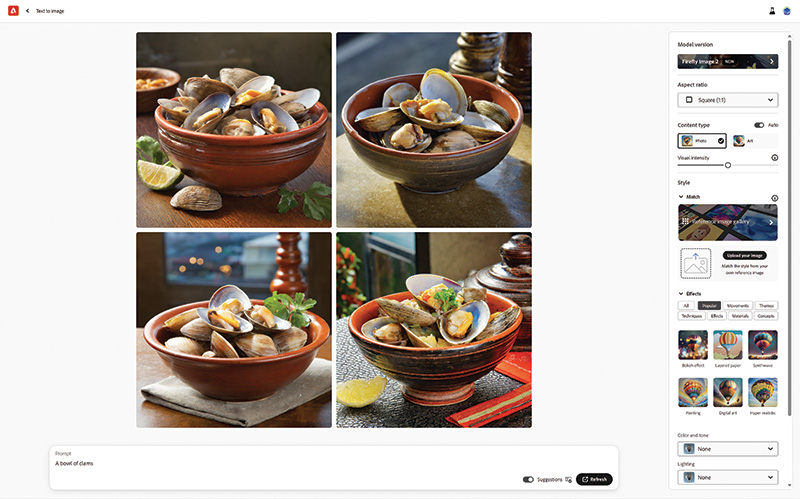Exploring Adobe’s Firefly: AI Image Generation for Restaurant Dishes
Artificial intelligence can generate photos, but it takes effort
For restaurant owners, the struggle to create beautiful, timely photo content is real. The abundance of professional food photography on social media has raised diners' expectations – turning everyone into instant food critics with every image swipe.
While capturing images with a mobile device is convenient, these snapshots can reflect poorly on the quality of a dish. Professional photo shoots produce beautiful content, but they are expensive and time-consuming.
Like so much of all industries, technology is presenting a possible solution: images generated by artificial intelligence.
How AI Image Generation Works
Since the launch of the first AI image generator DALL-E in 2021, many new products have surfaced, and like any first-to-market, the successors are better. AI image generators all have pros and cons, such as better output but with the danger of legal issues, Adobe’s Firefly is worth exploring. It works with both text prompts and a simple graphical user interface. Firefly, a part of Adobe’s suite of software products that include graphic design, video editing and photography, is also free of the copyright infringement issues suffered by other platforms.
AI generates results by referencing existing data; the output is only as good as the reference data. Firefly references Adobe’s entire stock photo library – more than 200 million photos – to generate AI images. Unlike other image generation platforms that reference the entire internet, Adobe guarantees AI images are free from copyright infringement.
While it’s the safest option (no one wants a legal headache from posting on social media an AI image that resembles one shot by a professional photographer), Firefly’s greatest strength has drawbacks – a copyright-safe image reference library has limitations. Sometimes the generated output won’t exactly match your dish or a specific ingredient.
Firefly is included in Adobe's Creative Suite applications Photoshop and Illustrator, but since it’s more than $50 per month, users can create 25 images per month for $4.99.


Getting Started With Firefly
Create an account on Firefly by accessing Adobe online, and start with a free plan. Enter a prompt such as “a bowl of clams.” Hit “generate.”
The AI images appear on the left, and controls for settings such as aspect ratio, style and effects are on the right to help further refine the images. The generated images match the general nature of the prompt.
The images can be downloaded from the existing options, but they can be further refined with a more specific prompt and by adding a reference image taken from a phone.
Under the prompt, add the specifics. In this case, a bowl of Manila clams with fried sausage garnished with kale. Then from the panel of choices on the right, upload the reference image.
The new ingredients listed in the updated prompt and shown in the uploaded reference image are reflected in the latest generated image set.

The new image set shows the ingredients correctly, but the photos lack the polish of professionally styled photography. Add detailed photographic terms to the prompt to add interest, such as a bowl of Manila clams with fried sausage garnished with kale.
These options are the best thus far, showing visual interest, simulated depth of field and more accurate ingredient details.

This reflects the final image from the four options to download at Firefly’s maximum resolution – 2,000 pixels square – not large enough for print resolution, but suitable for a social media post.
The final image represents the dish well enough, but a closer look at the ingredients isn’t best of show. Some elements are difficult to discern, and some just don’t look appetizing at all. It also fails to capture the correct plating and vibe that comes with professional photography or even a phone photo taken by an amateur who understands the basics of a good photo. While Firefly lacks in generating specific complex dishes, it can generate better images of basic foods, such as a cheeseburger, fries, a steak or simple desserts such as ice cream or crème brûlée.
More to Come
This technology has greatly improved since DALL-E, but there’s a long way to go. The amount of progress in AI image generation technology in such a short time is jaw-dropping. There is little risk in getting your feet wet. If nothing else, AI image generation could be an excellent way to supplement the never-ending demand of social media channels. Don’t sleep on this tech – start experimenting with AI image generators now so you’re ready for the next three years when AI can deliver better photos and even video. Yes, quality AI video is coming soon.

